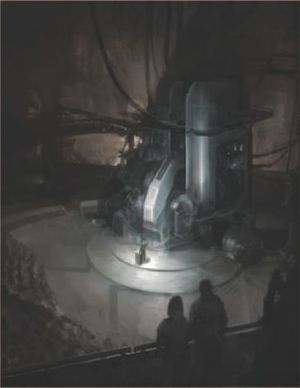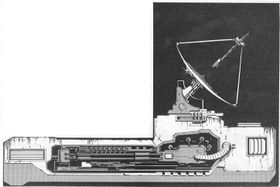Hyperpulse Generator
This article needs to be updated with material from Null Set, Patriots and Tyrants, A Bonfire of Worlds. Once these titles clear the Moratorium period, or if they already have, please consider revisiting this article and updating it with the new material. |
The Hyperpulse Generator (HPG) arrays are based on numerous worlds all across the Inner Sphere. ComStar owns and operates these, collecting payment from those who wish to transmit messages. The FTL devices are the primary means of interstellar communications, and ComStar has a virtual monopoly on their usage.
Contents
Overview[edit]
A hyperpulse generator (HPG) is a variant of KF drive technology based on an obscure speculation by Thomas Kearny and Takayoshi Fuchida that it might be possible to create artificial jump points. This proved correct, but the energy cost was such that it was not possible to send a ship through. Instead, the effect was harnessed to transmit electromagnetic signals - communications.
Each hyperpulse generator is essentially a small physics unit (with mobile units being as small as nine tons) which is able to fire a "pulse" through hyperspace to a receiving HPG. Because the HPG's messages are not burdened by tens or hundreds of thousands of tons of mass, the maximum range of an HPG pulse is 50 light years, while a ship can jump a maximum of 30 light years.
Each pulse can carry terabytes of compressed information, everything from simple text to books and video. One millisecond of transmission time, just enough for two pages of bare text or a small image, is equal to one C-bill, with larger items taking longer and thus having a higher cost. On average the time for transmission of a low-priority message between Terra and Tharkad takes about a week, and from Terra to the limits of the explored Periphery about six months. Priority message over the same distance could take between few hours to a day depending on conditions and network message load.
The Star League and ComStar HPG network is based on a simple two-stage system of primary or Class A "Hub" HPGs (the Prime or First Circuit), and a secondary network of Class B "Node"[1] hyperpulse relay stations (the Outer Circuit) determined upon the size the world, and its position, population and importance, with the over 50 Class A stations the network's main hubs and Class B stations located on virtually every Inner Sphere inhabited world. While processed serially, as transmission are expensive, messages are frequently bundled into batches of hundreds to be sent simultaneously. While the First Circuit consists entirely of Class A stations and transmits roughly every six hours, Class B stations are optimally to send twice a day.[1] After the fall of the Star League it may be days or weeks before a message is sent from the Class B stations of the Outer Circuit, though one can pay a higher fee in order to send a message sooner.[2][3][4][5]
Messages sent via ComStar and the Word of Blake are charged on per-transmission basis, dependent on how many stations the message must traverse to reach its destination. For example a 1 millisecond message worth 1 C-bill that must travel via 15 stations would have a final cost of 15 C-bills. Priority messages however are almost prohibitively expensive, an identical 1 millisecond message sent on a priority basis would be in the range of a 1,000 C-bills per station, with the station of origin also asking for an upfront 5,000 C-bill for interrupting the normal message schedule.[3]
All HPGs broadcast to all other HPGs within range. This safeguards against packet loss, with multiple copies making their way through the network. A specific path may be ordered for more secure messages, but any issues along the path may affect the message's delivery.[1]
Due to their relative proximity and small number, the stations of the Clan Homeworld HPG network are all of equal capacity, transmitting to each station within range as required. While utilizing a batch transmission schedule for general communication traffic, the limited size and close-ranges of this network also allow near-instantaneous real-time transmission, albeit with a 1.2 second delay for each station the signal must traverse.[6]
The fixed planetary networks in both the Inner Sphere and Clan space are also bolstered by portable transmitters aboard a small number of JumpShips and WarShips as well as message "buoys", allowing messages to traverse the gaps in and between each network. The most notable example of this was the chains of Clan WarShips and message stations set up to allow near real-time communications between the Inner Sphere and Clan Homeworlds for Grand Council meetings to elect Khans.[7]
The side effects of an HPG include substantial EMP that can temporarily disable battlefield targets. However, an HPG is designed to carefully target objects moving in predictable patterns many light-years distant (e.g., HPGs on other planets) and is thus essentially unable to "attack" battlefield targets.[8][9] The first known attempt to use an HPG as a weapon was in 3054,[8] when the Berenson HPG fired on investigating mercenaries.[10]
HPG Types[edit]

- Standard Planetary HPGs - The most common and familiar version in known space, the planetary HPG consists of a gigantic antenna dish surrounded by an installation that includes fortified EMP damping architecture, independent power supplies and large facilities for staff and operators. While stations of the original Star League were integrated into the communities they served, their vulnerability to attack during the Amaris Coup resulted in ComStar developing separate heavily protected compounds. These massive structures are virtual mini-fortresses designed as much to defend ComStar personnel from outside attack as to separate them from the influences of the general populace.[11]
- A typical compound has a façade that is aesthetically pleasing, partially to conceal the extent of their fortification. Usually it is surrounded by a ferrocrete wall that incorporates Star League-era surveillance equipment, supported in some cases by concealed minefields. A fusion reactor provides power independent of the local grid, with both it and the HPG housing encased in blast-proof materials; the entire facility can be sealed against the environment. Medical facilities (including surgical theaters) are present in many compounds. Food, water, and other supplies kept within storage facilities and elaborate underground tunnel networks—many large enough to accommodate BattleMechs—allow the staff to remain cut-off from the outside world for up to a year and a half. Escape tunnels also enable ComStar personnel to secretly enter and exit the facility as needed, with at least one connecting to the local ROM safe house.[11]
- A-rated HPGs transmitted to each B-rated HPG in range sequentially every 12 to 24 hours. Priority messages skip this sequence and go out immediately. During the Star League service was typically quicker[12]
- B-rated HPGs transmitted less frequently than A-rated HPGs. Generally this was every 12 hours during the Star League. During the Succession Wars this interval increased to or every few days.[12]
- ComStar also sometimes offered C- and D-rated services for major Periphery-state planets within 550 light-years of Terra. This was not via HPGs but courier JumpShips that provided scheduled message deliveries. C-rated serviced arrived every 3 months. D-rated services arrived once a year. These JumpShips also offered subsidized collars to traders’ DropShips.[12]
- Mobile HPGs - As well as the standard planetary station, the Terran Hegemony was also successful in miniaturizing the technology to develop Mobile Hyperpulse Generators. The most common form of mobile HPG is the 50-ton model, introduced in 2655, is installed upon large spacecraft, such as JumpShips and WarShips; an even smaller 12-ton ground-mobile model, designed for transport by ground vehicles or BattleMechs, was developed in 2751. While 50-ton mobile generators were relied upon heavily by the SLDF and the civil services of the Hegemony, in the modern era, only the Clans and the two interstellar service providers have access to the mobile systems; they are heavily guarded technologies.[13][9]
- Super-HPGs - Developed by the Word of Blake and first appearing during their Jihad, the so-called "Super-HPG" boasts a considerably increased range of nearly 1,000 light years (versus the standard HPG's 50 light year limit). However, unlike the Blakist Super-Jump Drive, the Super-HPG is a new and completely separate machine, rather than an upgrade to be applied to standard HPGs. Save for its increased range, in most respects the Super-HPG functions via the same transmission protocols as the standard version; both can receive messages sent by the other. However, the increased signal strength of the Super-HPG pulse generates localized hyperspace distortions that overpower and garble both conventional radio wave and standard HPG transmissions. The Blakists using this side effect to rapidly spread its HPG virus to ComStar-controlled Class A stations, sparking the "White-Out". Despite its tremendous advantages, the Super-HPG takes the complexity, rarity, and cost of the standard HPG to a higher level; even during the height of the Jihad, the Blakists could only operate six to twelve of the devices.[14]
History[edit]
Development[edit]
While first developed by the Star League during the period known as the Good Years, the origins of the HPG can be traced back to the equations of the great Professors Kearny and Fuchida. In one obscure section of their papers, published in 2022, they speculated on the possibility of creating artificial jump points and they provided the equations for generating them. Because the cost would have been astronomical, the scientific community did not pursue this hypothesis any further.
In 2614, First Lord Cameron appointed Joshua Hoshiko as Minister of Communications. The next year, Hoshiko enlisted Cassie DeBurke, a brilliant young professor from the University of Terra (located near the Court of the Star League), to study the problem further. DeBurke realized that the cost to transmit matter through artificial jump points might be prohibitive, but the cost to transmit bundles of energy - modulated energy, such as radio waves - was within the range of modest reactors. For the next 15 years, Professor DeBurke and her research staff worked secretly and feverishly on her theories. The culmination of their work was the first HPG station, built in 2629 just outside the Court of the Star League, which transmitted the first HPG message on New Year's Day 2630.[4]
By the time of Stefan Amaris’ coup, the Star League Communication Network (SLCOMNET) was at its peak, linking every single inhabited world throughout the Inner Sphere and Periphery, backed up by mobile transmitters aboard many official Terran Hegemony civil-service and military JumpShips and WarShips. With the First Circuit located on the worlds of the Hegemony, the network suffered extensive damage during the Amaris Civil War and among the last decisions made before the collapse of the Star League council was the selection of Jerome Blake as Minister of Communication in 2780, entrusted with restoring the war-ravaged communications network. As the highest-ranking member of the SLCOMNET hierarchy who was not captured or killed during the Amaris coup, Blake’s heroic efforts to maintain communications during the crisis earned him a reputation for integrity.[15]
ComStar Monopoly[edit]
By 2785, Blake had managed the herculean task of rebuilding the First Circuit, linking the reconstructed A-stations on several key Hegemony worlds, but as the threat of open warfare between House Lords increased Blake recognized the need to prevent the Successor States from seizing the interstellar communications network and misusing it for their own destructive ends. To this end in 2788 Blake seized Terra and reformed the vestiges of the SLCOMNET into ComStar, offering secure interstellar communication to all Successor States that would pledge to respect the neutrality of ComStar's facilities and personnel. The Inner Sphere leaders recognized that open communications were crucial to their survival and agreed to Blake's demands.[16]
Blake created the First Circuit, a council made up the administrators of the First Circuit HPG stations, to administer ComStar's affairs. His successor, Conrad Toyama, fostered a "secret brotherhood" mentality among ComStar's members in order to keep the secrets of the Star League safe. Toyoma's successors continued this trend, almost entirely replacing its corporate structure with a rigid, religious hierarchy, and shrouded its activities in mystic rituals. While continuing to profess neutrality, as the religious trapping clouded Blake's original intention, the ComStar Order used its control of the HPG grid to allow the continuation of the Succession Wars and ensure its role as the sole controller of advanced technology, as well as using its brutal secret service ROM to protect its monopoly control of the network and prevent others from deciphering or recovering HPG technology.
With their faith in ComStar's neutrality finally shattered by the actions of Operation SCORPION in 3052, the Great Houses seized control of the HPG stations within their realms. However, initially lacking the ability to run the network they employed the now secular ComStar to do so on their behalf, though the Free Worlds League chose to allow the splinter Word of Blake faction control of the FWL HPG stations. As HPG technology slowly began to disseminate to the states of the Inner Sphere, despite the significant differences between ComStar and the Blakists, the HPG network ran relatively smoothly save for occasional instances of Blakists' propaganda inserted into messages and their eventual seizure of Terra.
This changed when as part of their Jihad against the Inner Sphere, the Word of Blake instigated a "white-out" in 3068, flooding the HPG grid with white noise, everything ranging from Blakist propaganda to utter gibberish, backing up transmissions for months and creating chaos that distracted their enemies from the Word's activities. After the Blakists were defeated, the HPG network returned to normal operation under ComStar and formed the cornerstone of the Republic of the Sphere, as it did the Star League before it.
Blackout[edit]
However in 3132, the Gray Monday attacks perpetrated by an unknown agent or agents disabled the HPG grid. Roughly 75% of the Inner Sphere's hyperpulse generators were nearly simultaneously destroyed, crippled, or in some other way damaged. Approximately 80% of the A circuit and a large portion of the B circuit were rendered inoperable by a computer virus which used a message cascade to burn out the HPG's transmission core. HPGs with components immune to this virus were attacked by forces unknown. It is unknown why or by whom this was done, but the actions crippled communications. Many important messages are now relayed via "pony express" DropShips to planets without a working HPG. Much like water resources and working factories in the Succession War era, planets with a working HPG have become much more important and vital military targets.
It must be noted than the most primitive communication system called Black Box was initially unaffected by the attacks, and become the only universal and reliable communication system, though in a few years their communications ceased to be reliable.
Restoration[edit]
ComStar barely managed to restore three HPGs, some only temporarily, and even after years of study, they didn't know how to restore more... but in 3152, Clan Sea Fox managed to restore another: Alyina.[17] The next year, the Foxes said they could restore all inactive HPGs, and used the promise to bargain for a truce in the Wolf Empire, but they haven't proved they can do so.[18]
Gallery[edit]
References[edit]
- ↑ 1.0 1.1 1.2 Historical: Liberation of Terra Volume 1, p. 15
- ↑ BattleTech: 25 Years of Art & Fiction, p. 8: "HPG communications"
- ↑ 3.0 3.1 MechWarrior, 2nd Edition, p. 152: "Hyperpulse Generator"
- ↑ 4.0 4.1 ComStar, p. 6: "Linking the Stars"
- ↑ BattleTech Compendium: The Rules of Warfare, p. 111: "Wolfnet Archive File: 32211-BF5-11/7/23"
- ↑ The Clans: Warriors of Kerensky, pp. 61–62
- ↑ Explorer Corps, p. 35: "Life in Space - HPG Communications"
- ↑ 8.0 8.1 Null Set, p. 45: "Hyperpulse Technology - Hyperpulse Generator"
- ↑ 9.0 9.1 Explorer Corps, p. 92: "New Equipment - Hyperpulse Generators"
- ↑ Null Set, p. 8-9
- ↑ 11.0 11.1 ComStar, p. 26: "ComStar Compounds"
- ↑ 12.0 12.1 12.2 Campaign Operations, p. 132
- ↑ Tactical Operations, p. 330: "Mobile Hyperpulse Generators"
- ↑ Jihad Hot Spots: 3076, p. 110: "Kearny-Fuchida "Super-HPG" Technology
- ↑ ComStar, p. 9: "The Collapse of the Star League"
- ↑ ComStar, pp. 11–13: "Birth of ComStar"
- ↑ Tamar Rising, p. 72
- ↑ Redemption Rites, p. 268
Bibliography[edit]
- BattleTech: 25 Years of Art & Fiction
- BattleTech Compendium: The Rules of Warfare
- The Clans: Warriors of Kerensky
- ComStar
- Explorer Corps
- Field Manual: Updates
- Jihad Hot Spots: 3076
- MechWarrior, Second Edition
- Null Set
- Second Succession War (sourcebook)
- The Star League
- Tactical Operations
- Tamar Rising




